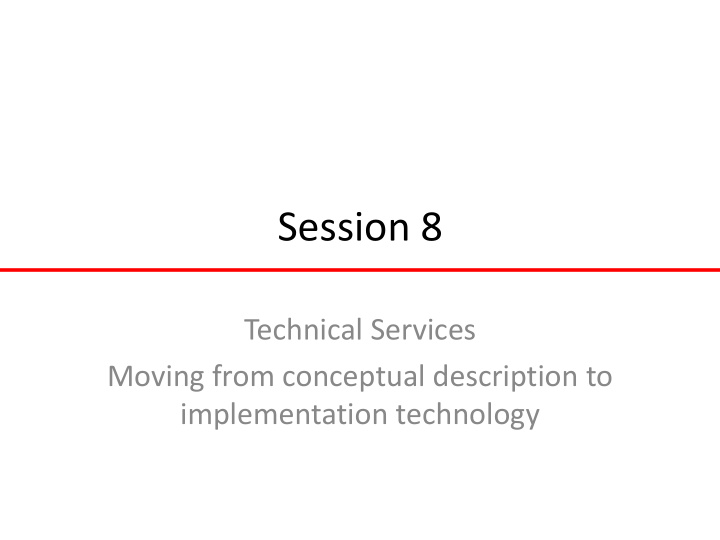



Session 8 Technical Services Moving from conceptual description to implementation technology
Semantic & Bibliographic Relationships • Concepts & resources don’t exist in isolation • Knowing & articulating relationships – Connects – Contextualizes
Semantic Relationships • Relationships among categories or concepts – If we plan to organize information, we should know how concepts can relate to each other. 1. Equivalence – Synonyms and quasi-synonyms, 2. Hierarchical – Class-subclass • Reptiles snakes – Whole-part • Knee Patella 3. Associative – The ‘clean - up’ relationship type, – Associations among concepts that are neither hierarchical nor equivalent
Types of Associative Relationships • A discipline or field of study and the objects or phenomena studied: – Forest Forestry • An operation or process and its agent or instrument: – Midwife Birth • An action and the product of the action: – Ploughing Furrows • An action and its patient or target: – Harvesting Crops • A concept and its unit of measurement: – Electrical power Watt
MeSH: Medical Subject Headings • 26,000+ descriptors – 177,000 terms – Roughly 6.8 synonyms per descriptor! • Created by NLM for indexing medical literature – Used worldwide • Faceted – Facets and qualifiers systematically establish rich, semantic relationships • http://www.nlm.nih.gov/mesh/MBrowser.html
MeSH Records • Descriptors – Main headings, preferred terms – Indicate aboutness, subject • Qualifiers – Subheadings – Indicate aspects of a subject. This is where facets come into MeSH – E.g., Administration & dosage, Anatomy & histology, Complications, Standards, Statistics & numerical data, Therapy – Very structured approach to facets • 83 qualifiers to be used in conjunction with descriptors for indexing a particular aspect of a subject • Supplementary Concept Records – Fast-changing, mostly to index substances (chemicals, drugs)
Bibliographic Relationships • These describe how different resources can relate to each other: • Similar to Semantic Relationships from Session 2, but these pertain specifically to bibliographic resources. – Equivalence: exact (or nearly exact) copies • 2 copies of the same edition of a book, an mp3 recording burned from a CD – Derivative: work that is based on or derived from another work • Updated edition, adaptation – Descriptive: work that describes another work • Criticism, commentary, summary (Cliff’s Notes)
Bibliographic Relationships – Whole-part: A work can be part of another work • Volume in an encyclopedia, chapter, article in a periodical, item in a series – Accompanying: A work that is meant to go with another work • Math workbook w/ textbook, index, documentation – Sequential: A work that precedes or continues an existing work. • Issues of a publication, sequels/prequels, items in a sequential series – Shared characteristic: Works that have something in common • Author, title, language, subject
Bibliographic & Semantic Relationships: Why care? • Concepts that are in semantic relationships with each other are linked. – If the type of link is definable in the information system, – If the link between two resources is encoded. • Resources that are in bibliographic relationships with each other are linked. – If the type of link is definable in the information system, – If the link between two resources is encoded.
RDA’s Purpose • “The data created using RDA to describe a resource are designed to assist users performing the following tasks: – Find —i.e., to find resources that correspond to the user’s stated search criteria – Identify — i.e., to confirm that the resource described corresponds to the resource sought, or to distinguish between two or more resources with similar characteristics – Select — i.e., to select a resource that is appropriate to the user’s needs – Obtain — i.e., to acquire or access the resource described .” – RDA Introduction
User Tasks • Find – meeting user’s search criteria • Identify – User confirms finding what they sought, distinguishes similar items • Select – Meets user’s requirements wrt content, format, etc. • Obtain – User’s ability to access the actual work • Navigate – User’s ability to use the work, find information within, etc.
Resource Description & Representation Technology • Most (all?) tasks and technologies involved in the organization of information/bibliographic control pertain to: – Entities – Characteristics of those entities – Relationships among entities
Entities Characteristics Relationships Databases Entities Attributes Relationships XML Elements Sub-elements & Nesting of Attributes elements; Namespaces FRBR / RDA Content entities, Attributes (of Relationships & Agent entities, content entities Linked Data Concept entities and agent entities) CMS Articles Article template Categories, (databases form fields Tags, Links, on the Feed backend)
Midterm’s Coming! • Any questions?
Recommend
More recommend